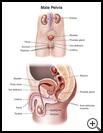
Epididymitis
________________________________________________________________________
KEY POINTS
- Epididymitis is irritation and swelling of the tube (epididymis) that stores and carries sperm from your testicles to your penis. The testicles are part of the male reproductive organs.
- Your healthcare provider may prescribe antibiotic medicine. Your sexual partner may need to be treated at the same time to prevent re-infection if a sexually-transmitted disease is the cause.
- Follow the full course of treatment prescribed by your healthcare provider. If you are taking an antibiotic, take all of it as prescribed, even if you no longer have symptoms.
________________________________________________________________________
What is epididymitis?
Epididymitis is irritation and swelling of the tube (epididymis) that stores and carries sperm from your testicles to your penis. The testicles are part of the male reproductive organs. They are in a sac of loose skin, called the scrotum or scrotal sac, which is below and behind the penis.
What is the cause?
Epididymitis can be caused by infections, blockages, or swelling and irritation (inflammation) of the urinary tract or reproductive organs. These infections, blockages, and inflammation may be caused by:
- Urinary tract infections
- Blockages in your urinary tract that you were born with
- A sexually transmitted disease or infection (also called an STD or STI) such as chlamydia or gonorrhea
- Infection of the prostate gland
- Tuberculosis (TB)
- Surgery, such as prostate removal or a vasectomy
- A medical procedure involving your urinary tract, such as cystoscopy or a urinary catheter
Sometimes men have epididymitis when they are taking a heart rhythm medicine called amiodarone. Sometimes no cause can be found.
What are the symptoms?
Symptoms may include:
- Pain in one or both testicles that comes on gradually, although epididymitis usually happens on just 1 side
- Red, warm, swollen scrotum
- Drops of pus from the opening of the penis
- Pain or burning when you urinate
- Pain with sex, including with orgasm
- Lump in a testicle
- Discomfort in your lower belly or side
- Blood in the semen
- Fever and chills
How is it diagnosed?
Your healthcare provider will ask about your symptoms and medical history and examine you. Tests may include:
- A rectal exam
- A testicle exam
- Urine tests
- Tests for chlamydia and gonorrhea
- Blood tests
How is it treated?
Your healthcare provider may prescribe antibiotic medicine. Your sexual partner may need to be treated at the same time to prevent re-infection if a sexually-transmitted disease is the cause. Your provider may prescribe another medicine for pain and swelling. The pain usually gets better in 1 to 3 days.
If you have an infection, it is very important to have a follow-up visit with your healthcare provider to make sure the infection is completely gone. If it is caused by a bacterial infection, the symptoms may come back if antibiotics do not kill all of the bacteria. If the infection spreads to the testicles, it could make you infertile (unable to have children).
Some men have chronic epididymitis, which means that the swelling goes away, but pain continues. If antibiotics and pain medicine do not help, you may need surgery to remove the epididymis. If only one is removed, you should still be able to have children.
How can I take care of myself?
- Follow the full course of treatment prescribed by your healthcare provider. If you were prescribed an antibiotic medicine, take the antibiotics for as long as your healthcare provider prescribes, even if you feel better. If you stop taking the medicine too soon, you may not kill all of the bacteria and you may get sick again. If you have side effects from your medicine, talk to your healthcare provider.
- Ask your provider:
- How and when you will get your test results
- How long it will take to recover
- If there are activities you should avoid and when you can return to your normal activities
- How to take care of yourself at home
- What symptoms or problems you should watch for and what to do if you have them
- Make sure you know when you should come back for a checkup.
- If you are very uncomfortable, you may need to rest in bed for a couple of days.
- Raise the scrotum by putting a rolled-up towel under it when you are resting.
- Put an ice pack, gel pack, or package of frozen vegetables wrapped in a cloth on the scrotum every 3 to 4 hours for up to 20 minutes at a time.
- Wear an athletic supporter or jockey shorts instead of boxers to help relieve discomfort.
- Take care of your health. Try to get at least 7 to 9 hours of sleep each night. Eat a healthy diet and try to keep a healthy weight. If you smoke, try to quit. If you want to drink alcohol, ask your healthcare provider how much is safe for you to drink. Learn ways to manage stress. Exercise according to your healthcare provider's instructions.
How can I help prevent epididymitis?
- Keep your penis and scrotum clean. If you are not circumcised, gently pull back the foreskin when you bathe or shower to clean the penis.
- If you have symptoms of burning when you urinate or a discharge from the penis, see your healthcare provider promptly.
- Practice safe sex:
- Use latex or polyurethane condoms during foreplay and every time you have vaginal, oral, or anal sex.
- Have just 1 sexual partner who is not having sex with anyone else.

